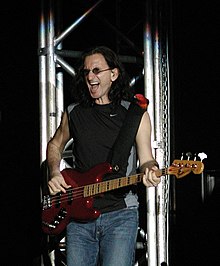Geddy Lee
[4] Lee joined the band in September 1968 at the request of his childhood friend Alex Lifeson, replacing original bassist and frontman Jeff Jones.
Lee's style, technique, and skill on the bass have inspired many rock musicians such as Cliff Burton of Metallica;[7] Steve Harris of Iron Maiden;[8] John Myung of Dream Theater;[9] Les Claypool of Primus;[10] Steve Di Giorgio of Sadus, Death and Testament;[11] and Tim Commerford of Rage Against the Machine and Audioslave.
[12] Along with his Rush bandmates – guitarist Alex Lifeson and drummer Neil Peart – Lee was made an Officer of the Order of Canada on May 9, 1996.
[16][23] Lee has suggested that his father's death was probably a factor in his becoming a musician: "It was a terrible blow that I lost him, but the course of my life changed because my mother couldn't control us."
By 1971, they were now playing primarily original songs in small clubs and bars, including Toronto's Gasworks and Abbey Road Pub.
They were holding down jobs during the weekdays and playing music on weekends: "We longed to break out of the boring surrounding of the suburbs and the endless similarities .
"[34] Short of money, they began opening concerts at venues such as Toronto's Victory Burlesque Theatre for the glam rock band New York Dolls.
[34] By 1972, Rush began performing full-length concerts, mainly consisting of original songs, in cities including Toronto and Detroit.
[36] From 1993's Counterparts onward, Lee began using the Fender Jazz Bass almost exclusively, returning to his trademark high treble sound.
Keyboard critic Greg Armbruster says the additional sounds from synthesizers expanded the group's "textural capabilities" and allowed the trio to produce an orchestrated and more complex progressive rock music style.
[38][full citation needed][39] Music industry writer Christopher Buttner, who interviewed Lee in 1996, described him as a prodigy and "role model" for what every musician wants to be, noting his proficiency on stage.
"[27] As a result, notes Mulhern, Lee's instrumentation was the "pulse" of the group and created a "one-man rhythm section", which complemented guitarist Alex Lifeson and percussionist Neil Peart.
[11] My Favourite Headache, Lee's solo album, was released on November 14, 2000, while Rush was on a hiatus following the deaths of Neil Peart's daughter and wife.
[42] Musicians associated with the project include friend and Rush collaborator Ben Mink and drummer Matt Cameron of Soundgarden and Pearl Jam.
While Rush has had great success selling albums, "Take Off" is the highest-charting single on the Billboard Hot 100 of Lee's career.
[45] Lee sang "O Canada", the Canadian national anthem, at Baltimore's Camden Yards for the 1993 Major League Baseball All-Star Game.
[46] Another version of "O Canada", with a rock arrangement, was recorded by Lee and Lifeson for the 1999 film soundtrack South Park: Bigger, Longer, and Uncut.
[47] Lee also plays bass on Canadian rock band I Mother Earth's track "Good for Sule", which is featured on the group's 1999 album Blue Green Orange.
In 2006, Lee joined Lifeson's supergroup, the Big Dirty Band, to provide songs accompanying Trailer Park Boys: The Movie.
[48] In 2017, Lee performed in place of late bassist Chris Squire with Yes during the band's Rock and Roll Hall of Fame induction, playing bass for the song "Roundabout.
[citation needed] In 2020, Lee provided guest vocals to an all-star Canadian rendition of the late Bill Withers song "Lean on Me" during the TV special Stronger Together, Tous Ensemble, a Canadian benefit performance simulcast by every major television network in Canada as a benefit for Food Banks Canada during the COVID-19 pandemic.
[52] In September 2021, Barenaked Ladies frontman Ed Robertson revealed that he was working on a "secret project" with Lee,[53] which turned out to be callouts for a subsequent Rush pinball machine.
[54] In 2022, he appeared as a guest star playing Thomas Sawyer on the acclaimed long-running CBC period drama Murdoch Mysteries.
[74] Inspired by the distinctive sound of Yes bassist Chris Squire, Lee then acquired a black Rickenbacker 4001 bass, which remained his main instrument from the 1970s up until the early 1980s.
[78] This signature model is a recreation of Lee's favourite bass, a 1972 Fender Jazz that he bought in a pawn shop in Kalamazoo, Michigan in 1978.
In 2015, Fender released a revised USA model of his signature bass,[79] with most of the changes reflecting those Lee had made to his own instrument over the years.
[85] With this technology Lee and his bandmates can present their arrangements in a live setting with the level of complexity and fidelity that fans have come to expect and without the need to resort to the use of backing tracks or employing an additional band member.
He began using Tech 21 SansAmp units after experimenting with one in the studio intended for Alex Lifeson's guitar[88] and eventually received signature models from the company, most notably the GED-2112 rackmount.
[89] Faced with the dilemma of what to do with the empty space left behind by the lack of large amplifier cabinets, Lee chose to decorate his side of the stage with unusual items.
[100] In 2011, a charitable foundation he supports, Grapes for Humanity, created the Geddy Lee Scholarship for winemaking students at Niagara College.





